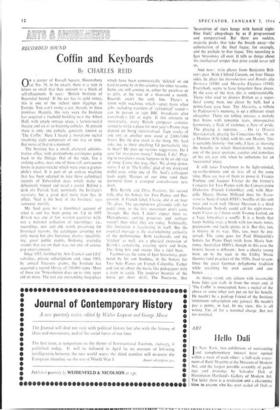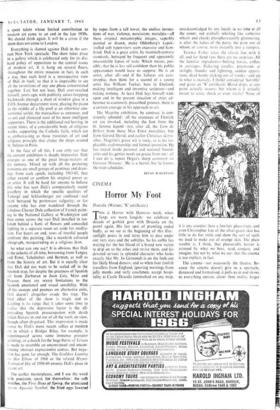Hello Dali
ITN New York, two exhibitions of outstanding complementary interest have opened within a week of each other: a full-scale assess- ment of Rene Magritte at the Museum of Modern Art, and the largest possible assembly of paint- ings and drawings by Salvador Dali at Huntington Hartford's Gallery of Modern Art. The latter show is a revelation and a chastening blow to anyone who has ever sealed off Dali as
a spent talent whose limited contribution to modern art came to an end in the late 1930s. We should think again. It will be a crime if the show does not come to London.
Everything is slanted against Dali in the cur- rent New York spectacle. The show takes place in a gallery which is celebrated only for its die- hard policy of opposition to the central issues of modern art. It is hung on several floors, throughout the entire museum in fact, in such a way that each level is a retrospective view of Dali in itself, so that it is impossible to see all the inventions of any one phase concentrated together. Last but not least, Dali over-reached himself, years ago, with publicity antics (stepping backwards through a sheet of window glass in a Fifth Avenue department store, playing the piano in the middle of a lily pool at an otherwise con- ventional soirée, the mustachios as antennae, and so on) and alienated most of his more intelligent supporters. There is the additional red herring, in recent times, of a considerable body of religious works, supporting the Catholic faith, which are as embarrassing as those travesties of art and religious principle that clutter the shops around St. Sulpice in Paris.
In the face of all this, I can only say that the current exhibition is deeply impressive. Dali emerges as one of the great image-makers of the century. Mixed up with all the posturing nonsense are small groups of paintings and draw- ings from each epoch, including 1963-65, that either extend or confirm his original power as an artist. It will be hard for anyone to believe this who has seen Dali's comparatively recent jewellery in which the specific qualities of Faberge' and Schlumberger are confused—and both betrayed by portentous vulgarity; or for anyone who has ever wandered through the fabulous Chester Dale collection of French paint- ing in the National Gallery at Washington and then come across the vast Dali installed in iso- lation behind a bank of flowers and concealed lighting in a separate room set aside for medita- tion. For hours on end, rows of trustful people confront this painting, like a mawkish coloured oleograph, masquerading as a religious ikon.
So what can one say? It is obvious that Dali is the eclectic of all time, borrowing from Tanguy and Ernst, Tchelitchev and Berman, as well as from the history of art. But it is equally clear that Dali did not want to be sealed off in the Spanish trap, for despite the greatness of Spanish art from Zurburan to Juan Gris, Miro and Picasso, there are severe limitations to the Spanish emotional and visual sensibility. With all his swoops and pounces on alternative exits, Dali doesn't altogether evade this trap. The final effect of the show is tragic and so dazzling is its range that it takes some time to realise that the depressive factor is the all- pervading Spanish preoccupation with death which flickers in and out of all the work on view, though often disguised. This impression is made worse by Dali's more recent sallies at modern art in which a Bridget Riley, for example, is superimposed across some immense porn pier painting: or a sketch for the huge Battle of Tetuan iN made to resemble an unconvinced and uncon- vincing abstract expressionist canvas. But nega- tion has gone far enough. The Goddess Leaning on Her Elbow of 1960 or the related Hyper- Xiological Sky of 1958-60 ensures Dali's piace in iecent art.
The earlier masterpieces, and I use the word With precision, speak for themselves : the soft watches, the First Days of Spring, the attenuated Spoon Agnostic Symbol, the fried eggs lowered
by ropes from a tall tower, the endless invoca- tions of war, violence, narcissism, nostalgia—all these original metamorphic images, superbly painted or drawn, make Oldenburg's kapok- stuffed soft typewriters seem excessive and ham- fisted. Dali is a great artist, by twentieth-century standards, betrayed by frequent and apparently unavoidable lapses of taste. Which means, pos- sibly, that he is less self-confident than his public appearances would have us suppose. He is an artist, after all—and if his failures are cata- strophic, then think for a second of a young artist like William Tucker, here in England, making intelligent and inventive sculpture—and risking nothing. At least Dali lays himself wide open and in the present situation of strict ad- herence to cautiously prescribed grooves, there is a certain courage in his approach to art.
The Magritte exhibition, by contrast, is con- sistently splendid: all the resources of Flemish art are invoked, including the lion from the St. Jerome legend—not, after all, the Lion de Be/fort from those Max Ernst moralities, but from Gerard David, and earlier Christian skirm- ishes. Magritte's grave wit is tonic, so is his im- placable craftsmanship and formal invention. He has stayed inside personal and national bound- aries and his genius needs no praise from me : all I can do is repeat Degas's sharp comment on Gustave Moreau: 'He is a hermit but he knows the train schedules.'
BRYAN ROBERTSON































 Previous page
Previous page